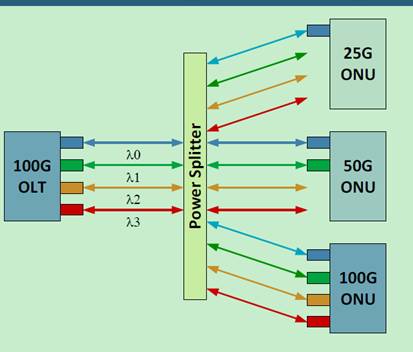Hi Glen and All:
I quite agree with Glen that “If 100G-EPON technology fails, It will be because of high cost”.
Let’s consider that why we choose the PON as the final access technology in the past. It’s due to that it’s a point to multi-point system, 32/64/128 users can
share one fiber , one OLT, that’s the reason PON is a low cost system.
When we consider 1G EPON, its’ 32/64/128 users sharing 1G bandwidth ,not a dedicating 1G bandwidth. So it’s same for 100G EPON. 100G EPON should be 32/64/128
users sharing 100G bandwidth. But the absolute majority 100G ONUs don’t need to support 100G peak rate.
That’s the difference between a single wavelength TDM system and a multiple wavelength system. For a single wavelength TDM system, the peak rate of ONUs is always
equal to the total system capacity . But for a multiple wavelength system, the peak rate of the ONUs is not necessary equal to the total system ! (The peak rate of a 100G EPON ONU can be only 25Gb/s)
The cost of ONUs are the majority cost of the total PON system, if we want to make a real low cost 100G EPON system, from me, we should focus on how multiple
ONUs with 25Gb/s peak rate to achieve a 100G EPON system.
By the way, I don’t mean I exclude the 100Gb/s peak rate ONUs, it can be applied for some very high-end users, but a 100G EPON ONU with only 25Gb/s peak rate
should be able to satisfy the major scenario in 100G EPON , from the cost effective consideration .
For page 7, I didn’t understand very well about what “100G ONU” really means, if all the 100G ONUs means a 100Gb/s peak rate ONU in the slides(as
they are shown in the figure), I need to differ with this.

Best regards
Dekun Liu
____________________________________________________
Advanced Access Technologies Dept.
网络研究接入技术部
Huawei Technologies Co., Ltd.
华为技术有限公司![]()
Phone: +86 027-59267217 Email: liudekun@xxxxxxxxxx
From: Glen Kramer [mailto:glen.kramer@xxxxxxxxxxxx]
Sent: Wednesday, February 17, 2016 3:05 AM
To: STDS-802-3-NGEPON@xxxxxxxxxxxxxxxxx
Subject: Re: [802.3_NGEPON] 802.3ca (100G-EPON) bi-weekly consensus - call for agenda items
Curtis,
I'd like to discuss the general architecture approach. We had a number of presentations in Dallas leading towards this approach, but since the Dallas meeting was per-TF, we didn't make any formal decisions. In Atlanta,
we started looking into various low-level details, but the big picture is left undefined. My slides are attached. All feedback is welcome.
Thanks,
Glen
On Mon, Feb 15, 2016 at 10:49 AM, Curtis Knittle <C.Knittle@xxxxxxxxxxxxx> wrote:
Dear Colleagues,
This coming Thursday, February 18, 11:30-1:00 Mountain Time, we will hold an IEEE 802.3ca 100G-EPON consensus building meeting. Please let me know by Wednesday
noon (Mountain Time) whether you have requests for agenda time.
If I do not receive agenda requests by noon Wednesday, I will cancel the meeting.
Thank you!
Curtis
Curtis Knittle
VP Wired Technologies – R&D
CableLabs
desk:
+1-303-661-3851
mobile:
+1-303-589-6869
Stay up to date with CableLabs: Read the blog and
follow us on Twitter
--
--------------------------------------
Glen Kramer
Broadband Technology Group
(707)529-0917